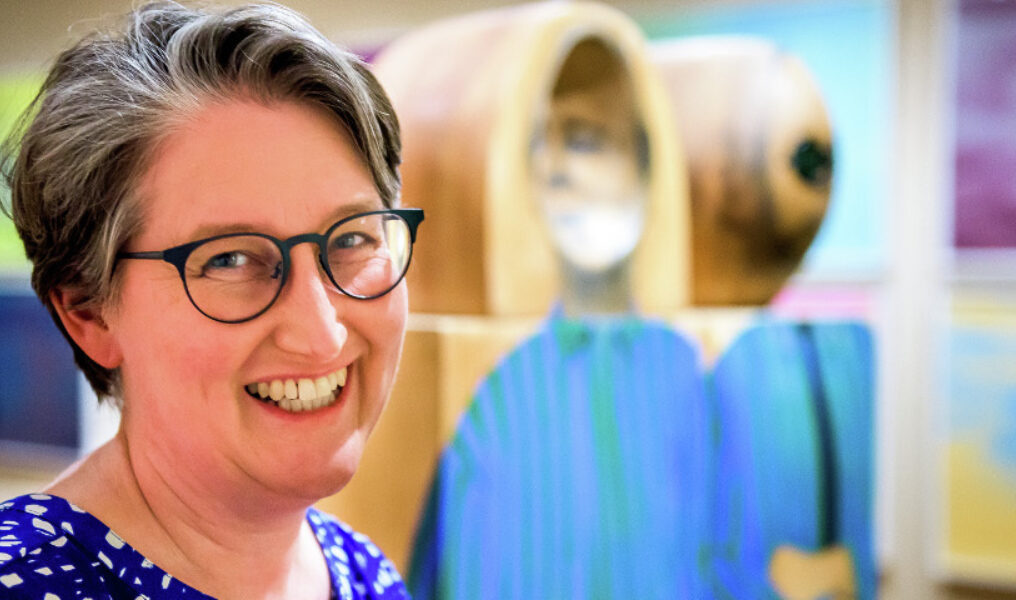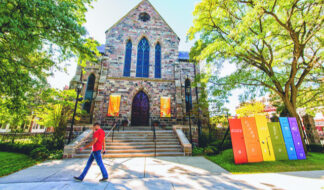Colors, clear-cut lines and often, deceptive simplicity; those are just a few common characteristics of the pop art movement and exactly what will grace the Detroit Institute of Arts' walls now through late August of this year in the exhibition "From Camelot to Kent State: Pop Art, 1960-1975." Featuring over 70 different objects from the height of the movement, it's a sampling of some of the best-known pop artists of all time, many of whom, like Andy Warhol, were openly LGBTQ. When asked why she chose this particular art form to be her debut exhibition in her current role at the DIA, Curator of Prints and Drawings Clare Rogan said that once she saw the DIA's existing pop art collection, it was an easy decision.
"This is an exhibition based on the DIA collection. Everything in the show, except for the Andy Warhol 'Electric Chair' — which is a wonderful loan from a local collector — belongs to the DIA," Rogan said. "One of the wonderful new things about coming to a new collection is discovering where they have incredible strengths. I started looking at the prints and drawings collection and I quickly realized that not only did we have wonderful pop art prints and pop art drawings but that we got them early on."
In fact, Rogan went on to say that many of the works in the DIA's collection were purchased within a year of their creation in the 1960s and '70s, at the height of the U.S. pop art movement. Perceptive DIA visitors might recognize a few of the pieces featured in this exhibition have been moved from their regular homes within the museum's contemporary galleries.
"The Oldenburg profile 'Airflow' and the sculpture, the 'Double Portrait of Henry Geldzahler' [by Marisol], are usually in our permanent galleries for contemporary art. But I wanted to bring them into context with the pop art prints, with the pop art multiples," Rogan said. "Multiples is a term used for three-dimensional editions, editions where instead of being a lithograph or a screen print, it's a three-dimensional object but it's not unique — there are a number of them, multiples. I wanted to bring them back into that context."
What is pop art?
Pop art is unquestionably eye-catching and bold, frequently using popular products as source material, and often, Rogan said, it delivers a message that's deeper than what initially meets the eye.
"Pop is really playful. It's witty, it's complicated and it's about embracing the world around us," she said. "It very much comes out of a moment in the '50s when artists were really focused on their inner thoughts, on reaching authenticity using techniques that tapped into very intuitive [places] very much inspired by Zen meditation."
And pop art, or "popular" art, was by many considered to be a direct answer to the abstract expressionists of the day like Jackson Pollock or Mark Rothko, by celebrating the everyday and banal. The British Tate galleries officially describe the movement as a "revolt against the dominant approaches to art and culture and traditional views on what art should be. Young artists felt that what they were taught at art school and what they saw in museums did not have anything to do with their lives or the things they saw around them every day."
That movement resulted in work like Warhol's "Campbell's Soup Cans," a 32-canvas installation that imitated a grocery store's display of the soup, an incredibly popular item of the day and something that only recently had become widely accessible. Though that particular work isn't available to view at this exhibit, Warhol's art, along with that of many of his contemporaries, appears in "Camelot to Kent State" and engages the viewer with that pop art mentality with what Rogan calls "a real celebration of popular culture."
"Really engaging with what was a wonderful period in economic growth of mass media, television, color television, advertising, Madison Avenue, comic books," she said.
What was perhaps most revolutionary about the pop artists of that time, too, was their use of materials and methods that were normally commercial like lithography and screen printing.
"And they're doing this at a time when many of the gatekeepers in art are saying, 'High art is very serious and low art is this mass-produced food, mass-produced packaging, magazines — this is low art,'" Rogan said. "And pop artists are playing with all of those definitions. They're reaching out and saying, 'Wait a minute, let's look more, let's celebrate, let's critique.'"
Perhaps one of the best examples in this exhibit of depth within a literally outwardly commercial package is Corita Kent's 1965 work "Enriched Bread." From the outside, the screen print obviously plays off the packaging of Wonder Bread, a new product at the time, but holds much deeper meaning when Kent's background is explored.
"She was a Roman Catholic nun in a convent in Los Angeles and was head of the art department for the college that the order ran. Though she was a nun, she was engaged with the outside world and fascinated with new technologies around the outside world like grocery stores," Rogan said. "[This print is] based on an advertisement of Wonder Bread and then the quote is from French existentialist writer and philosopher Albert Camus who famously created an essay that urged artists to connect with the outside world. This is a wonderful play between that philosophy and, at the same time as a Catholic nun, it's a metaphor of the Eucharist. It's working on all these different levels."
Camelot to Kent State
Entering the gallery space, the exhibit starts with James Rosenquist's "F-111" and leads through a selection of iconic works from across the realm of the '60s and '70s, and the rapid cultural change felt during that period. Rogan said that the title came from a period of time that not only was prolific for pop art but for U.S. history in terms of mass production, media and modern perceptions of the American dream.
"The title 'From Camelot to Kent State' is a rough arc, but in the early '60s with a new administration, John F. Kennedy, a young president, a young family in the White House, [there was] this sense of youth, of change, progressivism, of optimism," Rogan said, adding that the term Camelot of the Arthurian round table lovingly refers to Kennedy's time as president. "And in the United States particularly, the beginning of pop art is much more about embracing the positive sides of consumer culture and that shifts as you go along, and the whole politics and the turmoil of the '60s and early '70s, the Vietnam war, it shifts and it changes and there's a lot more critique going on in response to all that. I wanted to just gesture toward that arc."
And indeed, though presented through a seemingly bright, crisp and cheery lens, "F-111" does critique '60s society.
"In 'F-111' I used a fighter bomber flying through the flak of consumer society to question the collusion between the Vietnam death machine, consumerism, the media and advertising," Rosenquist said of his work.
The exhibit ends where the title suggests with a powerful and political image of the Kent State Shootings, an image caught by chance by British artist Richard Hamilton when he set his camera up in front of his television set.
"It happened to be the week of May 4, 1970, the week when the Ohio National Guard was called onto the campus at Kent State in response to protests against the Vietnam war and the expansion of it into Cambodia," Rogan said. "He was deeply shaken by it and he strongly opposed the Vietnam war and he felt that by making this he could help keep the shame in our minds. So, this is a screen print working with very, very accomplished German design press, 13 different colors and 13 different screens. [They are] aligned and created in a way that creates that flickering instability of the color television screen in the way that color TV was not crisp and it was wavy and moved and [emphasized] that sense of not quite knowing of what this horrific photograph is in front of us."
Though this style contrasts starkly with the bright, crisp lines and seemingly cheery presentation of the "F-111" bomber shown at the start of the exhibit, the use of the pop art is similar.
Filled With LGBTQ Icons
"Camelot to Kent State" isn't specifically an LGBTQ-themed exhibit, but it presents the work of many artists who were quite open about their identities at a time when it was still a crime in the U.S. Through the then unprecedented proliferation of media materials and the art form's general popularity, those LGBTQ creators like Warhol, Robert Indiana, Robert Rauschenberg and David Hockney still stand as icons not only in the art world but as LGBTQ trailblazers. Rogan herself is openly lesbian and pointed to the fact that pop art's prevalence is part of the reason that they were able to be so open and free with their identities — Warhol especially.
"I would say that pop art was very much part of the whole general social changes in the 1960s and 1970s and that the success of pop art allowed somebody like Andy Warhol who was, flamboyantly gay with his platinum hair and his slight figure, … [to push] the envelope," Rogan said. "And also, the success of pop art and the popularity of it gave it more visibility."
In that way, perhaps, pop art stands out among other popular art forms at the time in terms of shaping LGBTQ history. However, Rogan emphasized that pop art was only a piece of a much larger social movement that existed during the roughly outlined decade of her exhibit.
"I wouldn't tie [expansion of LGBTQ visibility] explicitly to pop art," she said. "I think it's part of broader, huge, dramatic social changes in the '60s and changes in approach to sexuality in general. With the birth control pill and a youth culture and civil rights movements, I mean, [there were] all of these different parts come together. So, I think pop art is as much along for the ride as it is changing anything."
To find out more about the DIA's "From Camelot to Kent State: Pop Art, 1960-1975" exhibit, visit dia.org.










